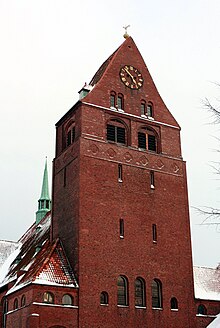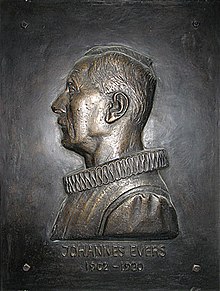St. Gertrud Church (Lübeck)
The St. Gertrud Church in Lübeck is the parish church of the Protestant parish in the Lübeck district of St. Gertrud , built according to a design by the Charlottenburg architects Jürgensen & Bachmann , which is consecrated to St. Gertrud von Nivelles . The patronage has been historical for the suburb on the castle field in front of the castle gate since the Middle Ages. In 1373 the Lübeck Bishop Burkhard von Serkem consecrated the first St. Gertruden Chapel.
history
The community of the Gertrudkirche above the Lübeck city park was created in 1902 through the division of the community of the Lübeck main church St. Jakobi . The population development of the suburb of St. Gertrud, which belongs to the Jakobigemeinde next to the northern old town, had multiplied from 934 inhabitants in 1845 to 7,777 in 1900.
The first pastor of the new congregation was Johannes Evers until 1920 . Like Johannes Bernhard with the new construction of the St. Lorenz Church , Evers was seen as the driving force behind her church planting and the construction of her church. The congregation elected him their chief pastor in 1909 . On his 75th birthday, the congregation honored her former shepherd, who was appointed senior of the Evangelical Lutheran Church in Lübeck in his last days in its church and then elected chief pastor of the Marienkirche for his work there . For this purpose she had a bronze relief made by Professor Hans Schwegerle , a son of Lübeck . This still hangs in the central church today.
His successor was Johannes Kanitz (1878-1939), the father of Joachim Kanitz . In the church struggle, Kanitz, his successor Hützen and his colleague Johannes (Hans) Schulz belonged to the Confessing Church , while the third pastor of the congregation, Horst Scheunemann, who came to the congregation in 1933 and stayed until 1973, was a supporter of the German Christians . The resulting tensions in the community culminated in early 1937 with the imprisonment of the organist Jan Bender .
The church building, for which donations had been collected from Lübeck citizens since 1899, was built from 1909 to 1910 by the Berlin architects Peter Jürgensen and Jürgen Bachmann as a brick building under the stylistic influence of the late Art Nouveau . The property was a donation from the Holy Spirit Hospital . The original interior was removed in 1962. In 1921 the church was given a memorial for its fallen soldiers in World War I based on a design by Max Kutschmann .
The single-nave church can accommodate around 700 people. It has three bells. The original bells were cast by M & O Ohlsson for the new building in 1909 and named after the reformers Luther, Melanchthon and Bugenhagen; the two smaller bells (Melanchthon and Bugenhagen) had to be delivered in 1915 in the First World War and the largest (Luther) in the Second World War and were thus lost. After the Second World War, replacements were created; a bell about 120 cm high was cast in bronze by JF Kreysell in 1728 .
organ
The organ built by the Walcker company in 1910 (opus 1537) with two manuals and pedal is one of the few surviving examples of romantic organ building in Lübeck. The disposition with predominantly soft, fundamental registers is based on symphonic-orchestral instruments. This is supported by the fact that the instrument is equipped with shutter thresholds. Game and stop actions are pneumatic.
In 1980 the instrument was renovated (also by Walcker, opus 5744) and an auxiliaire was added to its own drawer with six registers and a tremulant, so that baroque organ literature could also be performed on the organ. At the same time, the instrument received a new, additional movable console. The action became completely electric. In 2013 the pneumatic action was restored by Orgelbau Mühleisen .
|
|
|
|
||||||||||||||||||||||||||||||||||||||||||||||||||||||||||||||||||||||||||||||||||||||||||||||||||||||||||||||||||||
-
Pairing :
- Normal coupling: II / I, I / P, II / P.
- Sub-octave coupling: II / I
- Playing aids : a free combination, fixed combinations (p, mf, f, tutti without tongues, tutti), crescendo roller , calcant.
The young organist Jan Bender , who was accused of organ sabotage by the National Socialists during the Lübeck church fight in 1936, became famous .
See also
literature
- Hartwig Beseler (Ed.): Kunst-Topographie Schleswig-Holstein, Neumünster 1974, p. 155
- Uwe Müller: St. Gertrud: Chronicle of a suburban residential and recreation area . (Small booklets on city history, edited by the archive of the Hanseatic city of Lübeck , No. 2) Lübeck 1986. ISBN 3-7950-3300-4
Web links
Individual evidence
- ↑ Senior D. Evers. In: Lübeckische Blätter , 76th year, no. 43, edition of October 28, 19344 by senior public prosecutor i. R. Dr. Lienau.
- ↑ See Arndt Schnoor: Jan Bender - an eventful life. In: Der Wagen 1995 ISBN 3-87302-086-6 , pp. 101-107, as well as Dorothea Andersen: Church fight in Lübeck from the point of view of a community assistant. In: Wolfgang Prehn (ed.): Time to walk the narrow path. Witnesses report from the church fight in Schleswig-Holstein. Kiel: Lutherische Verlagsgesellschaft 1985 ISBN 3-87503-027-3 , pp. 135-142
- ↑ Hansjörg Buss: Laurel, oak leaves and a wreath of thorns. "War honors" of the Lübeck regional church in the Weimar Republic. In: Dietmar von Reeken , Malte Thießen (ed.): Ehrregime: Actors, practices and media of local honors in the modern age. Göttingen: V & R unipress [2016] ISBN 978-3-8471-0578-7 , pp. 201–220, here p. 207
- ↑ St. Gertrud Church. In: Internet presence of the parish. Evangelical Lutheran Church Congregation St. Gertrud zu Lübeck, accessed on January 6, 2016 .
- ↑ For description and disposition see Dietrich Wölfel: The wonderful world of organs. Lübeck as an organ city. Lübeck 2004 ISBN 3-7950-1261-9 , pp. 199-203
- ^ Organ in St. Gertrud. (No longer available online.) In: Internet presence Ev.-Luth. Church district Lübeck-Lauenburg. Ev.-Luth. Lübeck-Lauenburg church district, archived from the original on January 6, 2016 ; accessed on January 6, 2016 . Info: The archive link was inserted automatically and has not yet been checked. Please check the original and archive link according to the instructions and then remove this notice.
- ↑ The historic Walcker organ from 1910. In: Internet presence of the parish. Evangelical Lutheran Church Congregation St. Gertrud zu Lübeck, accessed on January 6, 2016 .
- ^ Inauguration of the Walcker organ on Sunday , article in hl-live on May 22, 2013, accessed on May 22, 2013
Coordinates: 53 ° 52 ′ 40 " N , 10 ° 42 ′ 25" E


